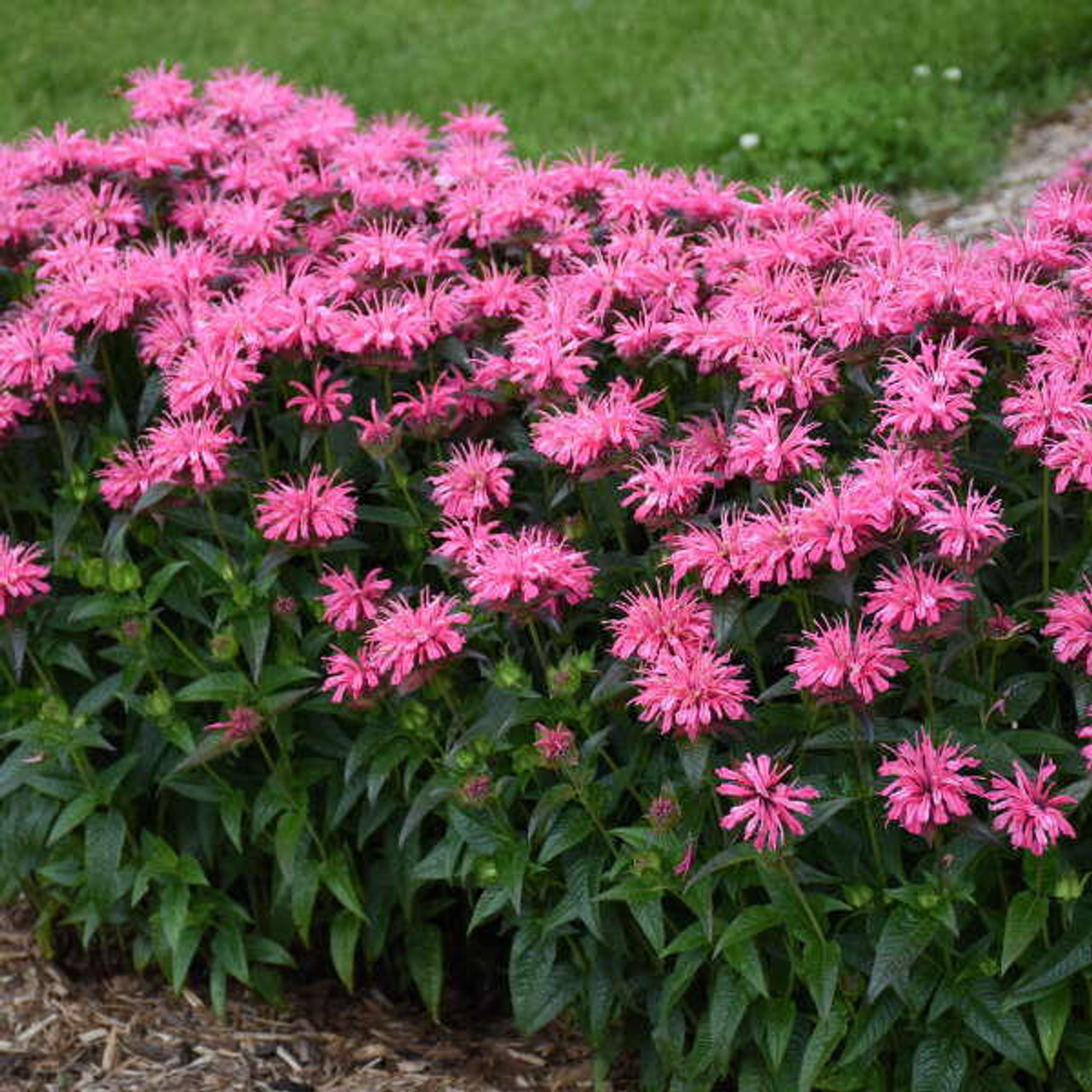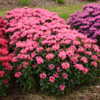Product Description
Monarda 'Pink Chenille' PPAF CPBRAF (20)ct Flat
UPSCALE™ Series
Common Name: Bee Balm
Prepare for UPSCALE™ Bee Balm to raise your expectations with a robust, substantial landscape presence. Taller than most other new introductions on the market, the UPSCALE™ collection average 2-2½' tall and wide with flowering performance that covers the top half of the plant. This series is excellent for landscape plantings and filling space in the middle of the border. Well branched stems support a second flush of flowers that extends the length of bloom, a trait that will delight both gardeners and the bees who frequent this popular pollinator perennial. Members of this collection all exhibit good mildew resistance.
'Pink Chenille' has large, 3½" fluorescent pink flowers have lighter pink interiors for a two-tone effect.
Monarda is native to eastern North America, so it is easy to grow and it multiplies quickly. The flowers' sweet nectar attracts scores of hummingbirds, butterflies, and bees to the garden. The aromatic foliage smells like mint when crushed and is often used to flavor teas.
Monarda can be found naturally along riverbanks and enjoys this rich, organic, moist soil. However, it will grow in average soil as well. Full sun is best, but light shade is tolerated. Plants tend to spread more quickly in the shade, however. Most monardas multiply rapidly either by underground stems or self-sowing. Deadheading spent blooms will prolong the bloom time.
Powdery mildew is a common fungal problem with monarda. Some varieties are more resistant to it than others. To prevent this fungus from appearing, large clumps should be thinned out so that the air circulates freely around them. The soil should also be kept consistently moist; dry soil promotes powdery mildew.
Height: 20.0-22.0 Inches
Spread: 18.0-22.0 Inches
Hardiness Zones: 4,5,6,7,8
Flower Color: Pink shades
Foliage Color: Green shades
Sunlight: Full Sun (> 6 hrs. Direct Sun) to Part Shade (4-6 hrs. Direct Sun)
Average to Consistent Water Needs
Average to Fertile Soil Quality
Bloomtime: Midsummer to Late Summer
Attracts Butterflies
Attracts Hummingbirds
Bee Friendly
Deer Resistant
Growth Rate: Medium
Border Plant, Cut Flower, Cut Foliage, Fragrant Flowers, Fragrant Foliage, Mass Planting
Monarda 'Pink Chenille' is a cultivar of bee balm, also known as horsemint, that is part of the Upscale™ series. It was developed by Proven Winners. This lovely plant is native to eastern North America.
Monarda 'Pink Chenille' has large, 3½-inch fluorescent pink flowers with lighter pink interiors, creating a striking two-tone effect. The unique flowers have a crown of spiky tubular petals, adding to their visual interest. The foliage is a vibrant green and releases a refreshing, minty fragrance when crushed. This fragrance is similar to that of oregano or mint, making it a delightful addition to sensory gardens.
'Pink Chenille' grows 20 to 22 inches tall and 18 to 22 inches wide, making it a perfect mid-sized addition to any garden. It blooms from mid to late summer, providing long-lasting color. The stems are sturdy and well-branched, supporting a second flush of flowers that extends the bloom time. This cultivar exhibits good mildew resistance, making it a low-maintenance choice for gardeners.
This bee balm cultivar is a pollinator magnet, attracting hummingbirds, butterflies, and bees to the garden with its sweet nectar. It is also resistant to deer and rabbits, making it a good choice for gardens where these animals are a concern.
Monarda 'Pink Chenille' is a versatile plant with many uses in the garden. It can be used as an accent, in container gardening, for edging, erosion control, as a ground cover, for massing, in rain gardens, rock gardens, and for underplanting.
Monarda 'Pink Chenille' thrives in full sun to partial shade. It prefers moist, well-drained soil but can tolerate average soil conditions. It is important to provide good air circulation to prevent disease. Deadheading spent blooms will prolong the bloom time. This cultivar is hardy in USDA Zones 4 to 8.
This plant is relatively low-maintenance and requires no special winter care. To ensure proper air circulation and prevent disease, space plants at least 24-28 inches apart.
It is important to note that Monarda may be toxic to deer.
Companion Planting Monarda 'Pink Chenille' is a good companion plant for tomatoes, potentially improving their health and flavor.
Monarda 'Pink Chenille' is a beautiful and beneficial plant that is easy to grow and care for. It is a great choice for gardeners of all levels of experience. With its vibrant pink flowers, refreshing minty fragrance, and potential medicinal uses, Monarda 'Pink Chenille' is a versatile addition to any garden. It attracts pollinators, is deer and rabbit resistant, and has a rich history of both culinary and medicinal use. In the language of flowers, Monarda symbolizes compassion and sympathy, reflecting its soothing properties and uses.
(20) plants per flat (or tray). Approximate Plug Measurements: 4.25 inches deep x 2.75 inches wide.
Other Details
The most important part of the plant is its root system. Healthy roots are the foundation of a healthy, vibrant plant. The type of plug container used is based on the specific needs of the plants. Perennials offered as bare root traditionally perform better when planted as bare root.Planted in a specialized mix, potted plants have well established root systems. Top growth stage will vary depending on the current life cycle and time of year when shipped. In Winter and early Spring dormant plants may be shipped. Dormant plants may be planted right away, even before the last frost date.
Most bare root varieties are field grown for at least one season, though Hemerocallis and Hosta are grown for two seasons. The bulk of the soil is removed during the harvesting process and the tops of most varieties are trimmed back to the crown. They are graded, packed in shredded aspen or sphagnum moss and stored in freezers until ready to be shipped.
See our Container Sizes and Bare Root Perennials pages for more information.
Plant information and care is provided in the Overview section, Plant Genus Page and general information is provided in the Planting Care & Guides. Additional questions can be asked on each Plant page.
Plant Spacing: Using the maximum mature spread or width of a plant to guide spacing, ensures space to grow to full size. To fill an area sooner, plant them closer together. Just remember, future thinning or transplanting may be needed.
Water: Keep a close eye on newly planted perennials, especially throughout the first growing year. Most early plant loss is due to too much or too little water!









